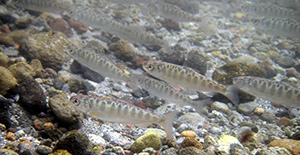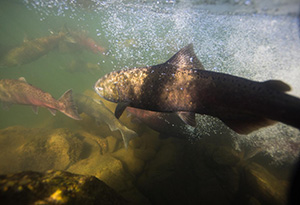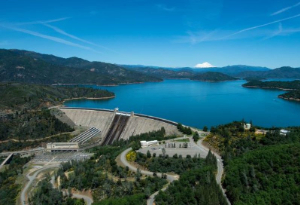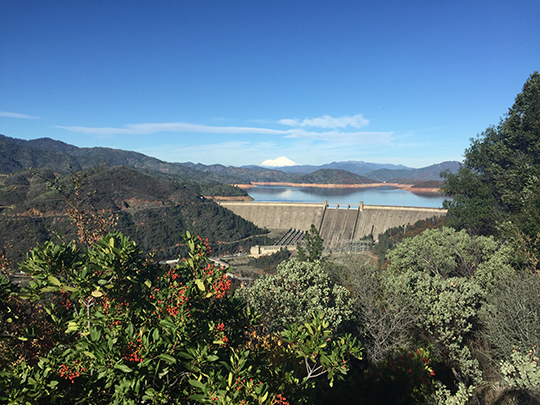- Reclamation
- California-Great Basin
- Area Offices
- BDO
- 2021 Consultation on the Coordinated LTO of the CVP and SWP
Long-Term Operation of the Central Valley Project and State Water Project
Photo Credit: Ben Nelson
The federal Central Valley Project (CVP) and the State Water Project (SWP) together provide water for more than 25 million Californians, millions of acres of some of the most productive farmland in the world. Water released from CVP reservoirs supports 19 federal, state and local wildlife refuges along the Pacific Flyway. The CVP and SWP provide flood management, protect and restore habitat for threatened and endangered species, supplement water supplies for local communities, produce clean and renewable hydroelectric power, backstop water quality in the Sacramento and San Joaquin Delta and support important commercial and recreational fisheries.
On Sept. 30, 2021, Reclamation and the California Department of Water Resources requested reinitiation of consultation on the Long-Term Operation of the CVP and SWP. with the U.S. Fish and Wildlife Service and National Marine Fisheries Service due to anticipated modifications to the proposed action that may cause effects to ESA-listed species and/or designated critical habitat not analyzed in the 2019 biological opinions.
On Feb. 28, 2022, a Notice of intent to prepare an Environmental Impact Statement (EIS) for the Long-Term Operation of the CVP and SWP was published in the Federal Register, followed by a series of public scoping meetings.
On July 26, 2024, Reclamation released the public draft EIS for the Long-Term Operation of the CVP and SWP. The public draft EIS evaluates four alternatives and a no action alternative. The alternatives cover CVP service areas and the operation of CVP dams, power plants, diversions, canals, gates and related federal facilities located on the Clear Creek watershed of the Trinity River Division, the Sacramento, American, Stanislaus, and San Joaquin rivers, and CVP and SWP facilities in the Sacramento-San Joaquin Delta and Suisun Marsh.
On Nov. 15, 2024, Reclamation released the final Environmental Impact Statement for the Long-Term Operation of the CVP and SWP. Prepared in accordance with the National Environmental Policy Act, the final EIS presents Reclamation’s analysis of the four alternatives and no action alternative that reflect a reasonable range of options for the operation of dams, powerplants, and related facilities of the CVP and Delta facilities of the SWP.
On January 24, 2025, President Donald J. Trump issued Executive Order 14181 “Emergency Measures To Provide Water Resources In California And Improve Disaster Response In Certain Areas.” A Presidential Memorandum titled “Putting People Over Fish” was signed four days before the Executive Order and references a reliable water supply, but the specific direction to the CVP is found in Executive Order 14181. Section 2 of Executive Order 14181 requires, among other measures.
(c) The Secretary of the Interior, including through the Bureau of Reclamation, shall utilize his discretion to operate the CVP to deliver more water and produce additional hydropower, including by increasing storage and conveyance, and jointly operating federal and state facilities, to high need communities, notwithstanding any contrary State or local laws. The Bureau of Reclamation shall take all available measures to ensure that State agencies — including the California Department of Water Resources — do not interfere with the Bureau of Reclamation’s operation of the project to maximize water delivery to high need communities or otherwise, including but not limited to the issuance of a new Record of Decision maximizing water deliveries and consistent with the 2020 Record of Decision.
Subsection (g) calls for a “proposed plan, for review by the Secretaries, to appropriately suspend, revise, or rescind any regulations or procedures that unduly burden such projects and are not necessary to protect the public interest or otherwise comply with the law.”
On December 4, 2025, Reclamation completed a 2025 Record of Decision to implement the “Action 5” Operations Plan for the Long-Term Operation of the Central Valley Project and State Water Project. Action 5 modifies components included in Alternative 2 in the 2024 Long-Term Operations Final Environmental Impact Statement (2024 LTO Final EIS). Alternative 2 was analyzed as the Proposed Action in the 2024 U.S. Fish and Wildlife Service and 2024 National Marine Fisheries Service Biological Opinions, described in the 2024 LTO Final EIS and identified as the “Preferred Alterative,” and selected in the 2024 LTO Record of Decision. Action 5 responds to Section 2 of Executive Order 14181 Emergency Measures To Provide Water Resources In California And Improve Disaster Response In Certain Areas by operating the Central Valley Project to deliver more water to high need communities, including by increasing storage and conveyance and coordinated operations of federal and state facilities. This Record of Decision implements initial actions in response to Executive Order 14181.
Where to Review: The final EIS is available for public review via the following ways:
Project Website: https://www.usbr.gov/mp/nepa/nepa_project_details.php?Project_ID=54661
Fact Sheet: New Plan for California Water: Updated Long-Term Operation of the Central Valley Project and State Water Project
Next steps = The schedule for the associated documents is below and subject to change
- CDFW Releases Incidental Take Permit – November 4, 2024
- USFWS Releases Biological Opinion – November 8, 2024
- Reclamation Releases Final EIS – November 15, 2024
- Final Environmental Impact Statement (project site)
- NOAA Fisheries Releases Biological Opinion – December 6, 2024
- The USFWS provided an amendment to the 2024 Biological Opinion with an updated incidental take statement on November 14, 2025 (Attachment 8 of the ROD)
- Reclamation Releases updated ROD – December 2025
Shasta StoryMap Chapter 1 - Operating Shasta in a New Climate: As the Bureau of Reclamation reinitiates of consultation on the long-term operation of the Central Valley Project and State Water Project under the Endangered Species Act, this multimedia presentation explains the amazing degree of complexity and challenges facing planners as they ponder the operation of Shasta Reservoir in a new paradigm.

Shasta StoryMap Chapter 2 - Applied Science and Analysis of Alternatives: Chapter 2 of the Shasta StoryMap delves into the extensive and multitiered modeling tools used to help planners envision scenarios and propose operations alternatives designed to achieve water supply reliability in an environmentally sustainable manner.

Shasta StoryMap Chapter 3 - Shasta and the long-term operation plan for the Central Valley Project: Achieving durability and equanimity for multiple needs. As Reclamation issues its draft environmental impact statement for the long-term operation of the CVP and SWP, this chapter looks at the incorporation of climate change conditions into the plan for operation and the efforts to protect winter-run Chinook salmon.

The Initial Alternatives Report (Sept. 2022) documents the analysis of options to inform alternative formulation for the proposed Long-Term Operation of the Central Valley Project and State Water Project. Initial alternatives were developed through the National Environmental Policy Act (NEPA) scoping process, coordination under the Water Infrastructure Improvement for the Nation (WIIN) Act, interagency coordination teams, outreach to interested parties, and Reclamation’s decades of experience in operating the CVP.
- Long-Term Operation, Initial Alternative (PDF - 1.3 MB)
- Appendix A – Facility Descriptions (PDF - 2.5 MB)
- Appendix B – Seasonal Water Operations and Ecosystem Analyses (PDF - 2.7 MB)
- Appendix C – Species Spatial-Temporal Domains (PDF - 3.8 MB)
- Appendix D – Seasonal Operation Stressors on Aquatic Species (PDF - 2.2 MB)
- Appendix E – Exploratory Modeling (PDF - 5.3 MB)
- Appendix F – Potential Common Components (PDF - 2.5 MB)
- Appendix G – Specific Facility and Water Operations Deconstruction (PDF - 402 KB)
- Appendix H – Conservation Measure Deconstruction (PDF - 1.7 MB)
- Appendix I – Old and Middle River Flow Management (PDF - 28 MB)
- Appendix J – Spring Pulses and Delta Outflow - Smelt, Chinook Salmon, and Steelhead Migration and Survival (PDF - 1.1 MB)
- Appendix K – Summer and Fall Delta Outflow and Habitat (PDF - 2.7 MB)
- Appendix L – Shasta Coldwater Pool Management (PDF - 9.7 MB)
- Appendix M – Folsom Reservoir Flow and Temperature Management (PDF - 2.9 MB)
- Appendix N – New Melones Stepped Release Plan (PDF - 483 KB)
- Appendix O – Tributary Habitat Restoration (PDF - 548)
- Appendix P – Delta Habitat Restoration (PDF - 1.6 MB)
- Appendix Q – Georgiana Slough Barrier Non-Physical Barrier (PDF - 410 KB)
- Appendix R – Head of Old River Barrier (PDF - 3 MB)
- Appendix S – Governance Under Development for the Draft EIS (PDF - 101 KB)
- Appendix T – Drought Under Development for the Draft EIS (PDF - 151 KB)
- Appendix U – Monitoring Under Development for the Draft EIS (PDF - 151 KB)
- Appendix V – Screened Scoping Comments (PDF- 833 KB)
- Public Scoping Report: 2021 Reinitiation of Endangered Species Act Section 7 Consultation on the Long-Term Operation of the Central Valley Project and State Water Project (PDF - 374 KB)
- Attachment A: Scoping Meeting Notification (PDF - 348 MB)
- Attachment B: Scoping Meeting Materials (PDF - 2.4 MB)
- Attachment C: Scoping Comments (PDF - 22 MB)
- Reinitiation Letter, September 30, 2021 (PDF - 170 KB)
- FWS Response Letter, October 1, 2021 (PDF - 165 KB)
- NMFS Response Letter, October 1, 2021 (PDF - 149 KB)
Note: documents in Portable Document Format (PDF) require Adobe Acrobat Reader 5.0 or higher to view download Adobe Acrobat Reader.


